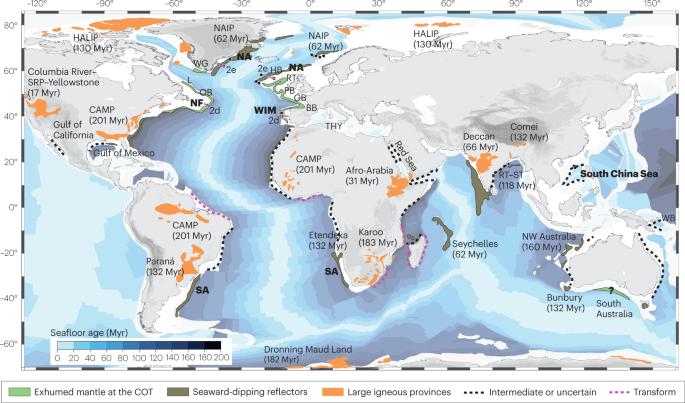Towards a process-based understanding of rifted continental margins
引用次数: 4
Abstract
Interactions between tectonic, magmatic, sedimentary and hydrothermal processes during rifting and break-up of continental lithosphere lead to a variety of rifted margin types. As potential reservoirs for mineral deposits and native hydrogen, and as sites for CO2 storage and generation of geothermal energy, rifted margins are likely to have a key role in the future transition to a carbon-neutral economy. In this Review, we discuss the wide variability of rifted margin anatomy in terms of the processes that shape them. We demonstrate that observations combined with models can provide a process-based understanding of margin evolution that allows any given region to be understood more holistically than with a static end-member type (magma-rich versus magma-poor) classification. Many margins show intermediate characteristics between those end-members. Even within end-member types, there are substantial structural variations, which are shaped by the feedbacks between inheritance, deformation, sedimentation, magmatism and fluid flow. A better understanding of these feedbacks is required to assess the potential of margins to support the carbon-neutral economy. Integration of observations and modelling will help to de-risk exploration of these environments. In particular, margins need to be characterized by integrated geophysical studies, including improved wide-angle seismic velocity models with closely spaced instruments together with advanced numerical modelling techniques. Continental margins record the last stages of rifting before a new ocean basin is formed, with their variety reflecting interactions between tectonic, magmatic, sedimentary and hydrothermal processes. This Review provides a process-based understanding of rifted margin formation, gaining insights into their resource potential for the energy transition.

基于过程理解裂陷大陆边
在大陆岩石圈的断裂和破碎过程中,构造、岩浆、沉积和热液过程之间的相互作用导致了各种断裂边缘类型。作为矿藏和原生氢的潜在储藏地,以及二氧化碳封存和地热发电的场所,断裂带边缘可能在未来向碳中和经济过渡的过程中发挥关键作用。在这篇综述中,我们从形成裂缘的过程角度讨论了裂缘解剖结构的巨大差异。我们证明,观测与模型相结合,可以提供对边缘演化过程的基于过程的理解,从而比静态的末端成员类型(富岩浆与贫岩浆)分类更全面地理解任何给定区域。许多边缘显示出介于这些终成岩类型之间的中间特征。即使在末段岩体类型中,也存在着巨大的结构差异,这些差异是由继承、变形、沉积、岩浆作用和流体流动之间的反馈作用形成的。要评估边缘支持碳中和经济的潜力,就必须更好地了解这些反馈。观测与建模相结合将有助于降低这些环境的勘探风险。特别是,需要通过综合地球物理研究来确定大陆边缘的特征,包括利用间距较近的仪器和先进的数值模拟技术改进广角地震速度模型。大陆边缘记录了新海盆形成前的最后断裂阶段,其多样性反映了构造、岩浆、沉积和热液过程之间的相互作用。这篇综述提供了对断裂边缘形成过程的理解,深入探讨了它们在能源转型中的资源潜力。
本文章由计算机程序翻译,如有差异,请以英文原文为准。
求助全文
约1分钟内获得全文
求助全文

 求助内容:
求助内容: 应助结果提醒方式:
应助结果提醒方式:


